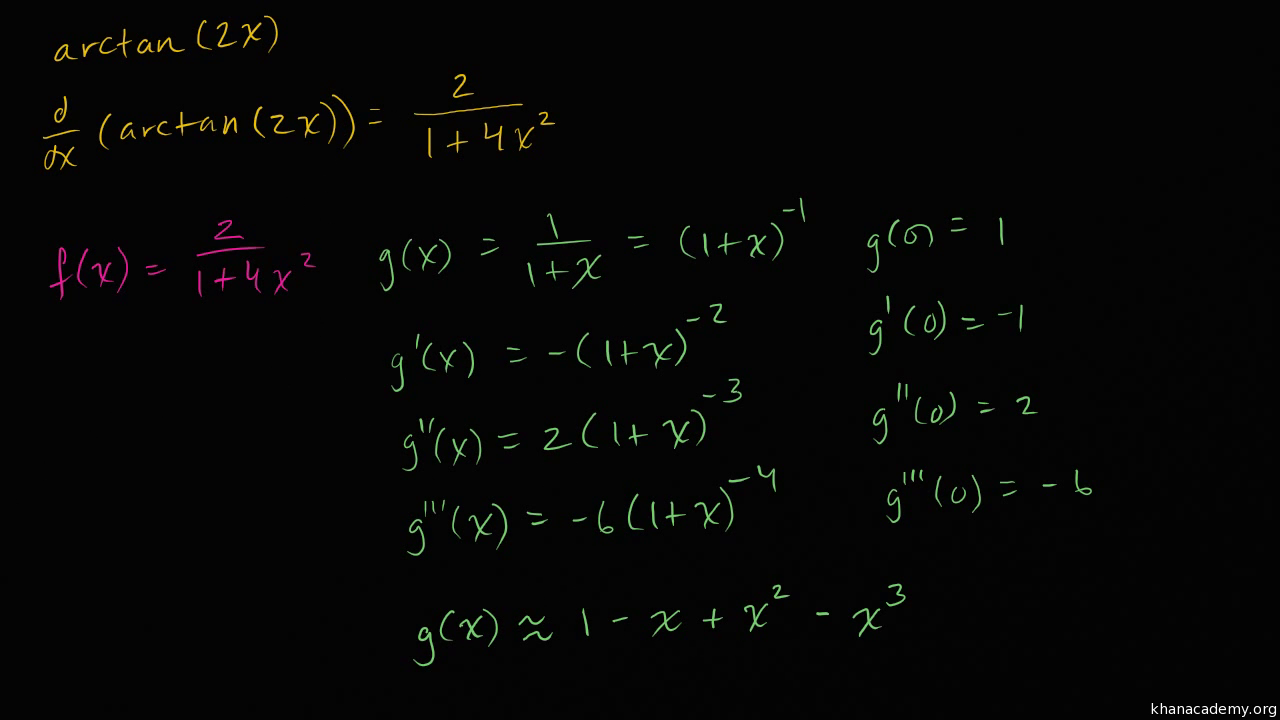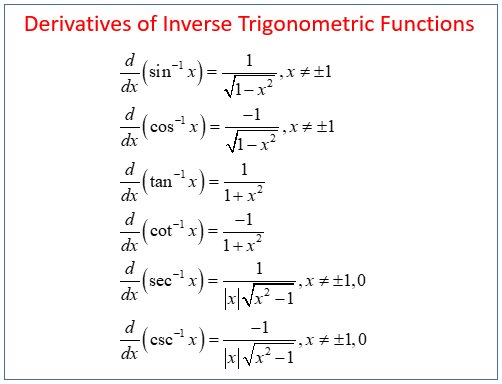Derivative Of Arctan
What is the derivative of #y=arctan(cos(x))#?
- Calculate the derivative of the function (y = arccos x arctan x ) at (x = 0. ) Example 9 Using the chain rule, derive the formula for the derivative of the inverse sine function.
- Find the Derivative - d/dx arctan(xy) Differentiate using the chain rule, which states that is where. Tap for more steps. To apply the Chain Rule, set as.
1 Answer
Jun 13, 2018 d/dx arctan(1/x) = -1/(x^2+1) We seek: d/dx arctan(1/x) Using the standard result: d/dx tanx=1/(1+x^2) In conjunction with the power rule and the chain rule we get: d/dx arctan(1/x) = 1/(1+(1/x)^2) d/dx (1/x) ' ' = 1/(1+1/x^2) (-1/x^2) ' ' = -1/((1+1/x^2)x^2) ' ' = -1/(x^2+1) Observation: The astute reader will notice that: d/dx arctan(1/x) = -d/dx arctan x From which we conclude that. The Derivative of Arctan X; y = tan−1 x tan y = tan(tan−1 x) tan y = x. So, we’re gonna. Let, the derivative of y = arctan of x. Y’ = 1/(1+x 2) and now we apply the function of tan to both sides to get tan y equals. Tan of arctan of X but tan and arctan. Inverse functions. So, they cancel out so, we get tan of y equals x and now we.
This is a case of knowing the how the derivative of inverse tangent works, and then following the chain rule.
If we were looking at
First remember that
So
Notice the tangent is no longer an inverse after the switch.
Now we can use implicit differentiation. That's where we don't care whether or not we're looking at a function, that is, we don't care if we have y on one side and everything else on the other. We just derive everything as we go along, and we write
So we derive
and we get
which is the same as

Which seems straightforward enough. Except for one thing. We don't usually have derivatives that still have y's in them. Not in the first year of Calculus, anyway. We should get rid of that y.
We can go back to a right triangle here. We started with

So:
Then by the Pythagorean Theorem, the hypotenuse can be found:

So the
meaning that if
then
which is the same as
So if we're looking at

The chain rule say that if you have an 'inside function' and an 'outside function,' then you take the derivative of the outside function, and multiply that by the derivative of the inside function, or
If
Notice the inside function does not change when you derive the outside function.
If
Finally:
since the derivative of
Written more simply,
Hope this helps.
Related topic
Questions
Related questions
Formula
$dfrac{d}{dx}{, tan^{-1}{x}} ,=, dfrac{1}{1+x^2}$
Introduction
The inverse tangent function is written as $tan^{-1}{x}$ or $arctan{(x)}$ in inverse trigonometry, where $x$ represents a real number. The derivative of the tan inverse function is written in mathematical form in differential calculus as follows.
$(1) ,$ $dfrac{d}{dx}{, Big(tan^{-1}{(x)}Big)}$
$(2) ,$ $dfrac{d}{dx}{, Big(arctan{(x)}Big)}$
The differentiation of the inverse tan function with respect to $x$ is equal to the reciprocal of the sum of one and $x$ squared.
$implies$ $dfrac{d}{dx}{, Big(tan^{-1}{(x)}Big)}$ $,=,$ $dfrac{1}{1+x^2}$
Alternative forms
The differentiation of the tan inverse function can be written in terms of any variable. Here are some of the examples to learn how to express the formula for the derivative of inverse tangent function in calculus.
$(1) ,$ $dfrac{d}{dy}{, Big(tan^{-1}{(y)}Big)}$ $,=,$ $dfrac{1}{1+y^2}$
Derivative Of Arctan(y/x)
$(2) ,$ $dfrac{d}{dl}{, Big(tan^{-1}{(l)}Big)}$ $,=,$ $dfrac{1}{1+l^2}$
Derivative Of Arccos
$(3) ,$ $dfrac{d}{dz}{, Big(tan^{-1}{(z)}Big)}$ $,=,$ $dfrac{1}{1+z^2}$
Derivative Of Arctan(1/x)
Proof
Derivative Of Arctan(2x)
Learn how to derive the differentiation of the inverse tangent function from first principle.